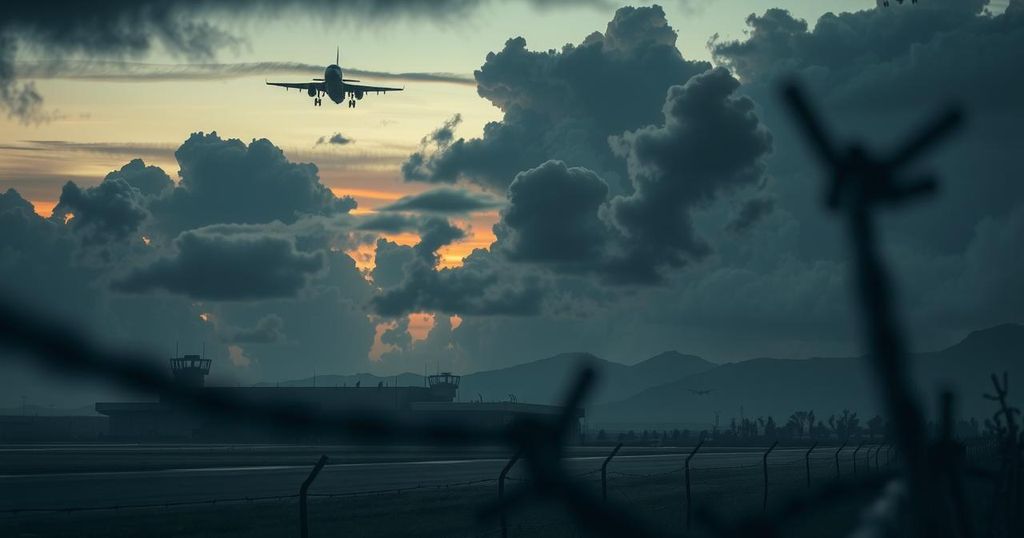Goma, DRC faces a severe crisis as the M23 armed group, believed to be supported by Rwandan forces, has taken control of the airport, intensifying ongoing conflicts. The situation has led to significant casualties, humanitarian emergencies, and widespread protests against perceived international inaction. The UN reported alarming humanitarian consequences as violence increases, putting pressure on local and international leaders to address the escalating conflict.
The city of Goma in the Democratic Republic of Congo (DRC) is facing a grave crisis as an armed group, the M23, alleged to be backed by Rwandan forces, has seized control of the airport. This takeover significantly weakens the position of Congolese forces and threatens the stability of the regional capital. Goma has transformed into a hotspot of conflict as M23 fighters entered the city after a rapid advance, leading to widespread chaos and humanitarian issues.
Reports indicate severe violence, with bodies on the streets and hospitals overwhelmed by casualties. As of now, it remains unclear which areas of Goma are under the control of the Congolese military and which are under M23 influence. However, a security source confirmed that M23 insurgents took the airport and that more than 1,200 Congolese soldiers have surrendered, seeking refuge with UN peacekeepers.
This escalation marks a disturbing development in eastern DRC, historically fraught with conflict since the Rwandan genocide. The United Nations has raised alarms about the rapidly worsening humanitarian situation, noting a significant displacement of people, food shortages, and illnesses due to lack of medical care. Goma, with a pre-crisis population of one million, now faces increased strain from an influx of internally displaced individuals, amplifying the crisis.
Eyewitness accounts highlight the dire circumstances, with individuals reporting bombings and shortages of basic necessities. Protests erupted in Kinshasa as citizens expressed outrage at perceived international inaction, attacking foreign embassies, including those of Rwanda, France, and the United States. In Goma, gunfire persisted, although the intensity of those confrontations reportedly lessened.
The UN has recorded at least 17 fatalities and 367 injuries from the recent clashes. The humanitarian agency emphasized that the situation around Goma continues to worsen, with reports of extensive gunfire and multiple deaths scattered across the city. Concerns arise regarding a laboratory in Goma containing viruses, as the Red Cross warned of possible catastrophic consequences if pathogens were released amidst the violence.
The African Union has urgently called for the M23 to cease hostilities. Meanwhile, Congolese authorities expressed frustration with the UN Security Council’s vague statements, alleging that Rwanda is exploiting the region’s natural resources amidst the conflict. Rwanda has denied these allegations, claiming its actions aim to combat the FDLR, an armed group from the Hutu faction.
The DRC government plans to hold discussions with Rwandan President Paul Kagame amid rising tensions. The emerging crisis follows a ceasefire in August, which failed, and previously mediated talks that were abruptly ended last month. This ongoing conflict is not new, as the M23 briefly held Goma in 2012 before being driven out by Congolese and UN forces. The situation is precarious, with Rwandan troops reportedly aiding the M23, raising further concerns about regional stability.
The current unrest in Goma, DRC, stems from a resurgence of the M23 armed group, which has historical ties to conflicts following the 1994 Rwandan genocide. The region has long been plagued by armed conflicts involving various factions, often backed by neighboring countries seeking control of its rich natural resources. This history of violence has created a cycle of humanitarian crises, as thousands are displaced, critical infrastructure suffers, and international responses are often seen as inadequate or reactive. The involvement of Rwandan forces adds an additional layer of complexity, with accusations and denials clouding the situation.
Goma’s situation exemplifies a critical humanitarian crisis exacerbated by armed conflict and regional tensions involving Rwanda and the M23 group. The UN and humanitarian agencies are calling for immediate international attention to prevent further escalation and to address the dire needs of the displaced populations. As protests in Kinshasa indicate public frustration with international responses, the DRC government seeks stronger action and engagement from regional partners, highlighting the importance of collaborative efforts in resolving the conflict and restoring stability in eastern DRC.
Original Source: www.wfxg.com






